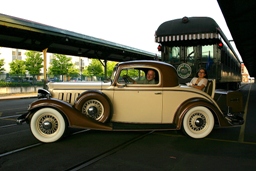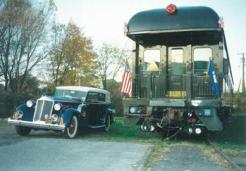New York Central 3 was one of four sister cars commissioned in 1927 by the New York Central Railroad and placed into service in 1928. However, its amenities were considerably different from the other three cars, because it was designed as the personal office car of Harold Sterling Vanderbilt, the last of the famous Vanderbilt Family to direct the New York Central Railroad. The most significant difference: It had a huge brick fireplace in the dining room. (Unfortunately, the fireplace was removed during a major post-war rebuild, and replaced by the present mahogany breakfront, which is an exact replica of the breakfronts initially built for the other three cars.)

NYC 3 dining area including the original fireplace, looking towards the kitchen end of the car, with the original dining room table fully collapsed. Although the fireplace has been removed, the dining room table is still aboard and in use. The breakfront which replaced the original fireplace is an exact duplicate of the breakfronts built in 1928 for NYC 3's sister cars.
Harold Vanderbilt was the great grandson of famous sea captain, railroad founder and fortune builder Commodore Cornelius Vanderbilt, who lived between 1794 and 1877. Successive generations of Vanderbilts continued to run the railroad and grow the family fortunes, culminating with Harold Vanderbilt, who was born in 1884 and lived into the 1970's.
The Vanderbilts were part of a world of luxury and excess that has seldom been equaled. As children, Harold, his sister, Consuelo, and his brother, William K. II, witnessed the lavish parties and elaborate balls staged by their mother for her advancement into New York Society and her fierce competition with Mrs. (Lady) Astor, long time Queen of New York. Their home was the storied Vanderbilt Chateau at 660 Fifth Avenue in New York City, and they summered at "Idlehour", on Long Island. They also visited their cousins at "The Breakers" in Newport, RI when they were in residence at "Marble House" and socialized there with August and Eleanor Belmont. Given such riches, it is not surprising that some of the later generation of Vanderbilts led somewhat unhappy and unproductive lives. But what is somewhat surprising is how multi-talented and productive much of this fourth generation was, even if their energies were not as focused as their forefathers.
Harold S. Vanderbilt fits in this latter category. He was a brilliant and analytical man, but while he controlled the Board of Directors of the New York Central, railroading was not his primary interest. His tenure included the wrenching changeover from steam locomotives to diesels and the resultant labor problems, the incredible demands of traffic generated by World War II, and the task of rebuilding a worn-out property while fighting a nasty proxy battle for control of the railroad with corporate raider Robert Young.
This period needed a strong leader to guide the railroad through it, but Harold chose to apply his considerable skills to defending the America's Cup with a series of J-Class sailing yachts. He won, brilliantly. His design inputs and superb organizational skills made his crews the best in the business. His wife, Gertrude, was the first American woman to crew aboard a Cup defender. His first boat, the "Enterprise", beat Sir Thomas Lipton's boat "Shamrock' in 1930, and the next entry, "Rainbow", defeated Sopwith's "Endeavor" in 1934. His last boat, "Ranger", again beat Sopwith in 1938. Ultimately, the Great Depression put an end to this type of yachting, and a year after the Ranger victory, Hitler's troops and tanks smashed into Poland, plunging the world into World War II.


The mid 1930's were optimistic years. The Great Depression was ending. Great structures were being built, including the Chrysler Building and Empire State Building in New York and California's Golden Gate and Bay Bridges. Southern Pacific's Daylight trains debuted. Vanderbilt's sailboat was winning. And both a 1936 Packard and 1933 Buick matched up well with his pre-Depression 1928 Pullman.
Yachting was not Harold's only passion. His great
grandfather, the Commodore, was an inveterate card player, and some
of his cousins and uncles were serious gamblers. Harold is credited
with inventing and refining the game of Contract Bridge - partly on
a transatlantic ocean cruise, partly at his yacht club and partly
on board NYC 3!
It's fascinating to speculate on what might have happened to the New York Central if Harold had focused more on railroading. His grandfather, William, had doubled the fortune he inherited from the Commodore, and his Uncle, Frederick, also doubled his money with the railroad. Harold's father, William Kissam, was also a "workaholic" type. When Harold started traveling in NYC 3 In 1928, the New York Central System boasted 11,500 road miles of track serving the Northeast, Middle Atlantic States, Great Lakes and Canada.
The "Great Steel Fleet" of passenger cars carried people everywhere from the resorts and great camps of the Adirondacks to Boston, New York to Chicago, two Canadian provinces, and hundreds of other destinations. Traffic was so heavy that the Central needed an unprecedented 6-track Main Line to carry it all, with four tracks on the Eastern Shore of the Hudson and two tracks on the parallel West Shore route.
The named trains were extensions of the grand hotels that their passengers frequented in the destination cities, and nothing was too good for these patrons. The "Twentieth Century Limited," probably the best known train of all time, was the flagship, but there were many others only slightly less luxurious, including the "Empire State Express," a New York-Buffalo premium train that frequently carried New York Central 3. As a result, the car's drumhead proudly carries its name today!
The modern stainless steel streamlined version of the "Empire State Express" had the misfortune to make its first run on December 7, 1941! World War II brought incredible demands for transportation to all the railroads, and the Central moved 54,941,598,120 ton-miles of freight and 9,291,910,179 passenger miles in the peak war years of 1943-44.
All this traffic had a serious downside. After the War ended, the New York Central was literally worn out. Steam locomotives went first, doomed by their high labor costs; old wooden boxcars and other obsolete rolling stock soon followed. Modern stainless steel cars pulled by diesels carried the passengers and innovating cargo containerization was featured on the freight trains. Unprofitable branch lines were sold or abandoned and torn up. Competition with the speed of the airplane and the convenience of the automobile, plus government subsidization of airport facilities and highways, handed the railroads a challenge that they could not overcome.
Besides these threats, corporate Robert Young mounted a campaign to take over the ailing road, portraying himself as the reformer as opposed to the "Old Line" lead by Harold Vanderbilt. A ferocious proxy fight further depleted the energy of the railroad. In 1954, Young won, but it was a true Pyrric victory. Harold Vanderbilt and his supporters resigned, and Young soon found that his approaches to the business were not as effective as hoped. He began casting about for merger partners, courting the Baltimore and Ohio Railroad and hiring ruthless cost-cutter Alfred Perlman as President.
Young's merger attempt with the B & O was soundly rebuffed, and the Chesapeake and Ohio wanted no part of him either. In dire straits, he began negotiations with the Central's arch-rival, the Pennsylvania Railroad. Negotiations progressed, but in January, 1958, perhaps envisioning what would soon happen to Eastern Railroading, Robert Young committed suicide, shooting himself to death in the library of his mansion in Palm Beach, FL.
The Penn-Central merger took place in 1961, but was delayed by government red tape and court actions until 1968. The resultant financial meltdown still has consequences today, and was the "Enron/Arthur Andersen" debacle of its time.
Harold Vanderbilt died in 1970, at the age of 86. Precious little remains of the Vanderbilt fortune, but Marble House and the Breakers in Newport survive as museums. (In fact, as a memorial to his mother, Harold bought Marble House in 1963 from the trust company that owned it.) Harold's Uncle, Frederick Vanderbilt's Hudson River mansion is also a museum in Hyde Park, New York. Vanderbilt University in Tennessee, founded by the Commodore and nurtured by successive generations, is still going strong. But perhaps the best memorial to them all is that, after all these years, much of the original route of the New York Central still sees daily passenger and freight traffic, and will continue to do so for decades to come.
